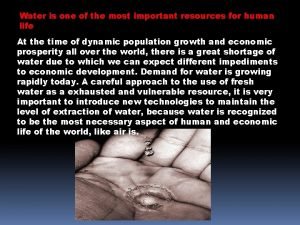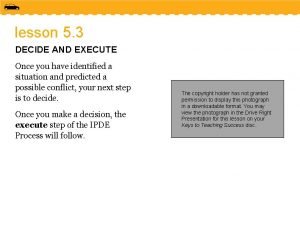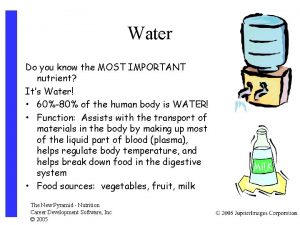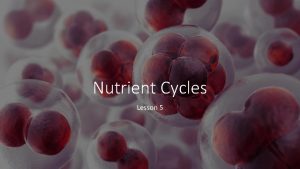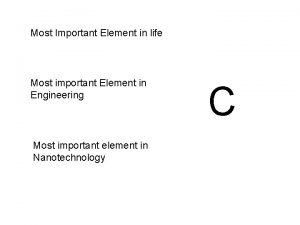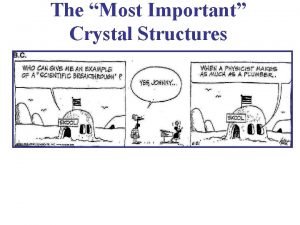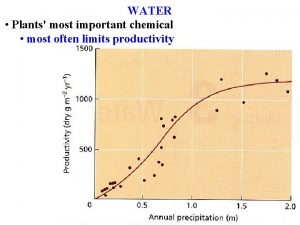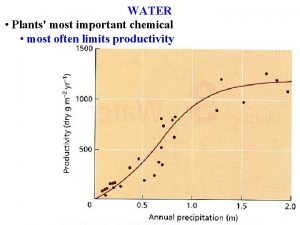Water Do you know the MOST IMPORTANT nutrient










- Slides: 10

Water Do you know the MOST IMPORTANT nutrient? It’s Water! • 60%-80% of the human body is WATER! • Function: Assists with the transport of materials in the body by making up most of the liquid part of blood (plasma), helps regulate body temperature, and helps break down food in the digestive system • Food sources: vegetables, fruit, milk The New Pyramid - Nutrition Career Development Software, Inc © 2005

Micronutrients • Minerals and vitamins are called micronutrients since they are needed by your body in SMALL amounts. • The minerals and most of the vitamins your body needs must be obtained from the FOODS you eat since your body cannot make them.

Micronutrients: Minerals • Minerals are INORGANIC substances that are required by your body in order to develop and grow properly. Some Important Minerals: • Calcium • Iron • Potassium • Magnesium The New Pyramid - Nutrition Career Development Software, Inc © 2005

Micronutrients: Minerals Calcium • Function: Helps build strong bones and teeth, regulates blood clotting • Food sources: dairy products, leafy and green vegetables Iron • Function: Helps build hemoglobin which is the oxygencarrying part of your red blood cells • Food sources: eggs, meats, whole grains

Micronutrients: Minerals Potassium • Function: Helps regulate fluid balance in the body, assists with the normal functioning of muscles and nerves • Food sources: bananas, carrots, milk The New Pyramid - Nutrition Career Development Software, Inc © 2005

Micronutrients: Minerals Magnesium • Function: Involved in the metabolism of proteins and carbohydrates, assists with bone growth and proper muscle functioning • Food sources: milk, meat, nuts The New Pyramid - Nutrition Career Development Software, Inc © 2005

Micronutrients: Vitamins: Group of complex compounds that help your body maintain normal metabolism, growth, and development Two Groups of Vitamins: • Water-Soluble • Fat-Soluble The New Pyramid - Nutrition Career Development Software, Inc © 2005

Micronutrients: Vitamins Water-Soluble Vitamins: • Vitamins that dissolve in water and are NOT stored in your body for future use Examples of Water-Soluble Vitamins: • Vitamin C: Fights against infection, maintains healthy gums, strengthens and maintains blood vessel structure – Food sources: citrus fruits, tomatoes, leafy vegetables Vitamin B Complex/Folic acid: Helps prevent birth defects, and is needed in the formation of red blood cells and nucleic acids – Food sources: beets, broccoli, avocado, turkey, bok choy, and lentils.

Micronutrients: Vitamins Fat-Soluble Vitamins: • Vitamins that dissolve into and are transported by fat • They can be stored in fat tissue, the liver, and the kidneys. Examples of Fat-Soluble Vitamins: • Vitamin A: Maintains good vision, promotes body cell growth, helps protect teeth – Food sources: green vegetables, dairy products • Vitamin D: Promotes the development of healthy bones and teeth – Food sources: eggs, salmon, fortified breakfast cereal. Other sources include sunlight.

Bibliography “Benefits of Exercise. ” Healthclubs. com. 2005. IHRSA. org. 19 Sept. 2005. <http: //www. healthclubs. com/benefits/>. “Fad Diets: What You Need to Know. ” Familydoctor. org. Apr. 2005. American Academy of Family Physicians. 19 Sept. 2005. <http: //familydoctor. org/784. xml>. “Glossary. ” Beaumont Hospitals. 2005. William Beaumont Hospitals. 19 Sept. 2005. <http: //www. beaumonthospitals. com>. Holt, Rinehart, and Winston. Life Science (Teacher Edition). Prentice Hall. Englewood Cliffs, New Jersey. , 2005. “Iron – Sources and Functions. ” Nutrition and Fitness Software by Nutri. Strategy. 2005. Nutri. Strategy. 19 Sept. 2005. <http: //www. nutristrategy. com/nutrition/iron. htm>. Kemp, Gina, M. A. , and Robert Segal, M. A. “Healthy Restaurant Eating / Fast Food Nutrition: Guide to Making Healthy Choices. ” Helpguide. org. 10 June 2004. Rotary Club of Santa Monica. 19 Sept. 2005. <http: //www. helpguide. org/aging/fast_food_nutrition. htm>. “Medline Plus Medical Encyclopedia. ” Medline Plus. 9 July 2004. U. S. Library Of Medicine. 19 Sept. 2005. <http: //www. nlm. nih. gov/medlineplus/ency/article/002468. htm>. Merki, Mary Bronson, Ph. D. , Merki, Don, Ph. D. Health: A Guide to Wellness. Glencoe Mc. Graw-Hill, 2001. “Vitamins. ” A. D. A. M. Healthcare Center. 2005. New York Times Company. 19 Sept. 2005. <http: //adam. about. com/encyclopedia/002399. htm>. “What does organic mean? . ” Pick. Your. Own. org. 9 Jan. 2003. Benivia, LLC. 19 Sept. 2005. <http: //www. pickyourown. org/organic. htm>.
 Venkatraman ramakrishnan medium
Venkatraman ramakrishnan medium Water and water and water water
Water and water and water water Example of a news story
Example of a news story From most important to least important in writing
From most important to least important in writing Least important to most important
Least important to most important Water is one of the most important resource
Water is one of the most important resource Identify predict decide execute
Identify predict decide execute Know history know self
Know history know self Dilan gorur
Dilan gorur I know who goes before me i know who stands behind
I know who goes before me i know who stands behind So you think you know minecraft
So you think you know minecraft





